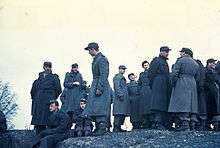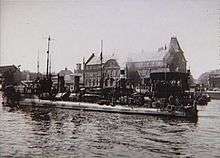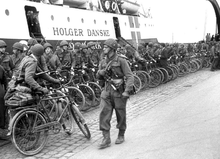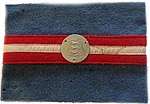Danish Brigade in Sweden
| Danish Brigade in Exile | |
|---|---|
| Den Danske Brigade | |
| Active | 1943–1945 |
| Countries |
|
| Allegiance |
|
| Branch |
|
| Engagements | Liberation of Denmark |
| Insignia | |
| War flag |
.svg.png) |

The Danish Brigade in Sweden (Danish: Den Danske Brigade i Sverige) or in short, the Danish Brigade (Den Danske Brigade/DDB) (also referred to as Danforce) was a military unit made up of Danish refugees during World War II. Trained and supplied by Sweden, the brigade was created to help liberate Denmark. Ultimately it was only deployed on the day of the German surrender in the country and was involved in very little fighting.
Background
Om 9 April 1940 Denmark was invaded by Nazi Germany and quickly surrendered. While most of the Danish Army followed the order to capitulate, one unit did not lay down its arms. Colonel Bennike, the commander of the 4th Regiment based at Roskilde, believed that the order to surrender had been forced on the government by the Germans and that Sweden had also been attacked. Instead of surrendering, Bennike and his unit boarded the ferry in Elsinore to Sweden and went into exile. After the misunderstanding was later cleared up, most Danish soldiers stayed in Sweden while others returned to Denmark.[1]
Following the transit of German troops through Sweden, Prime Minister Per Albin Hansson pushed for the training and equipping of 7,500 Danish "police troops." This was met with opposition in his cabinet, but a plan was eventually agreed upon in December 1943.[2]
History

The Swedish government loaned 25 million kroner to the Danish legation to fund the training and arming of the Brigade.[3] Enrollment was on a voluntary basis.[4] The Danish soldiers from Roskilde formed the nucleus of the new force.[1] Around 750 Jews who had escaped occupied Denmark enlisted.[4] The Danish soldiers were equipped with Swedish Mauser m/96 long rifles and bayonets.[5]

In the fall of 1944 the Swedish Air Force oversaw the training of Danish pilots at Såtenäs, who were subsequently organized into a squadron equipped with Saab 17 bomber-reconnaissance aircraft.[6]
The Danish Flotilla
The Danish Flotilla (Danish: Den Danske Flotille) was formed with ships of the Danish Royal Navy that had escaped to Sweden.
Liberation of Denmark
The Swedish government delayed the deployment of the Brigade to Denmark so as to not complicate the surrender of German forces there.[6] Most of the German occupation force surrendered without incident to Allied troops on 5 May. However, three Danish soldiers were killed by snipers as they marched into Copenhagen.[7]
Legacy
Most of the officers of the Brigade were influenced by the Swedish military doctrine (which was based on German strategy) they learned during their exile and carried their knowledge over into the restructured Danish Army following the war.[8] On the anniversary of Operation Safari in 1947, veterans of the Brigade erected a monument to the three soldiers killed during liberation near the Provincial Archive of Zealand in Copenhagen.[7]
Notable members
See also
Citations
- 1 2 Nigel 2014, p. 5.
- ↑ Gilmour 2011, p. 101.
- ↑ Bak 2011, p. 113.
- 1 2 Werner 2009, Chapter 5: Refuge in Sweden.
- ↑ Brayley 2004, p. 57.
- 1 2 Gilmour 2011, p. 102.
- 1 2 Bak 2011, p. 267.
- ↑ Pommerin 2014, p. 62.
- ↑ Mikkelsen, Morten (26 August 2013). "When Denmark Stood Up Against the Germans". Kristeligt Dagblad (in Danish). Retrieved 23 December 2017.
References
- Bak, Sofie Lene (2011). Nothing to Speak of: Wartime Experiences of the Danish Jews 1943-1945 (illustrated ed.). Museum Tusculanum Press. ISBN 9788763539586.
- Brayley, Martin (2004). Bayonets - An Illustrated History (illustrated ed.). Krause Publications. ISBN 9780873498708.
- Gilmour, John (2011). Sweden, the Swastika and Stalin: The Swedish experience in the Second World War. Societies at War (illustrated ed.). Edinburgh University Press. ISBN 9780748686667.
- Nigel, Thomas. (2014). Hitler’s Blitzkrieg Enemies 1940: Denmark, Norway, Netherlands & Belgium. London: Osprey Publishing. ISBN 978-1-78200-596-4.
- Pommerin, Reiner (2014). Clausewitz goes global: Carl von Clausewitz in the 21st century. BoD – Books on Demand. ISBN 9783937885780.
- Werner, Emmy E. (2009). A Conspiracy of Decency: The Rescue of the Danish Jews During World War II (reprint ed.). Basic Books. ISBN 9780786746699.
